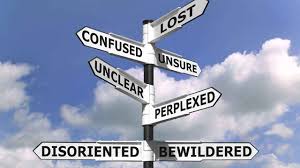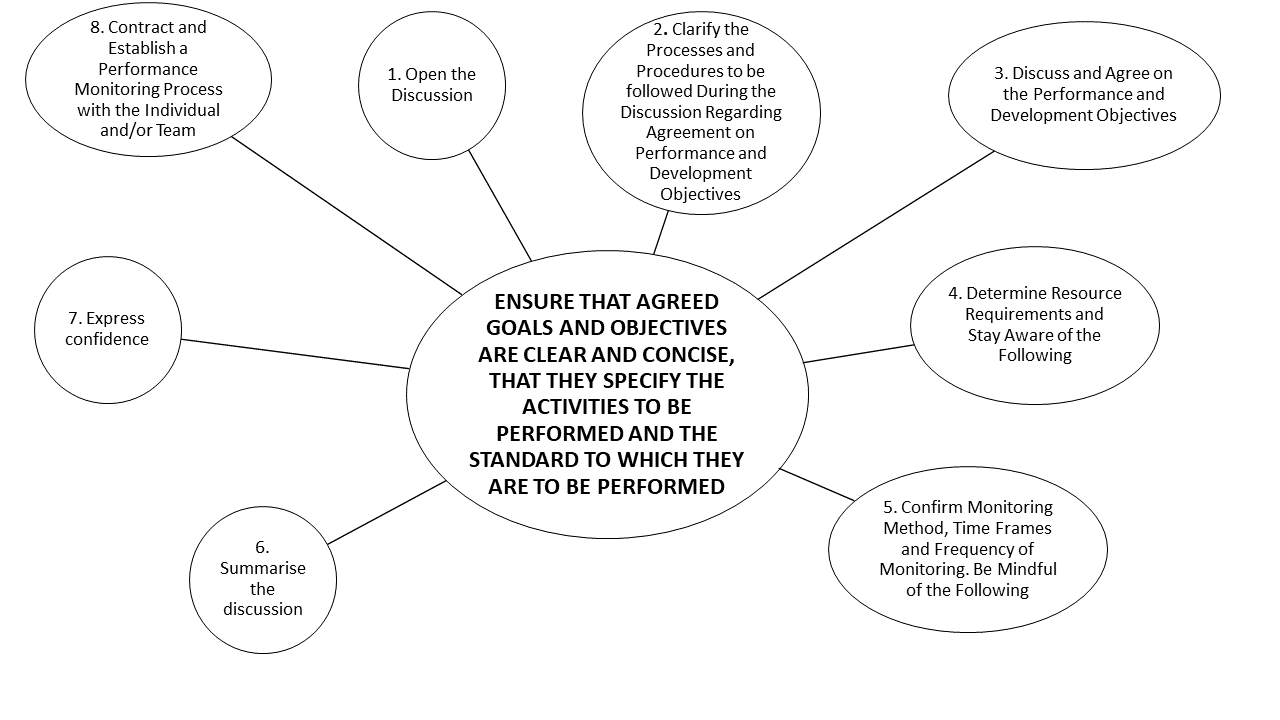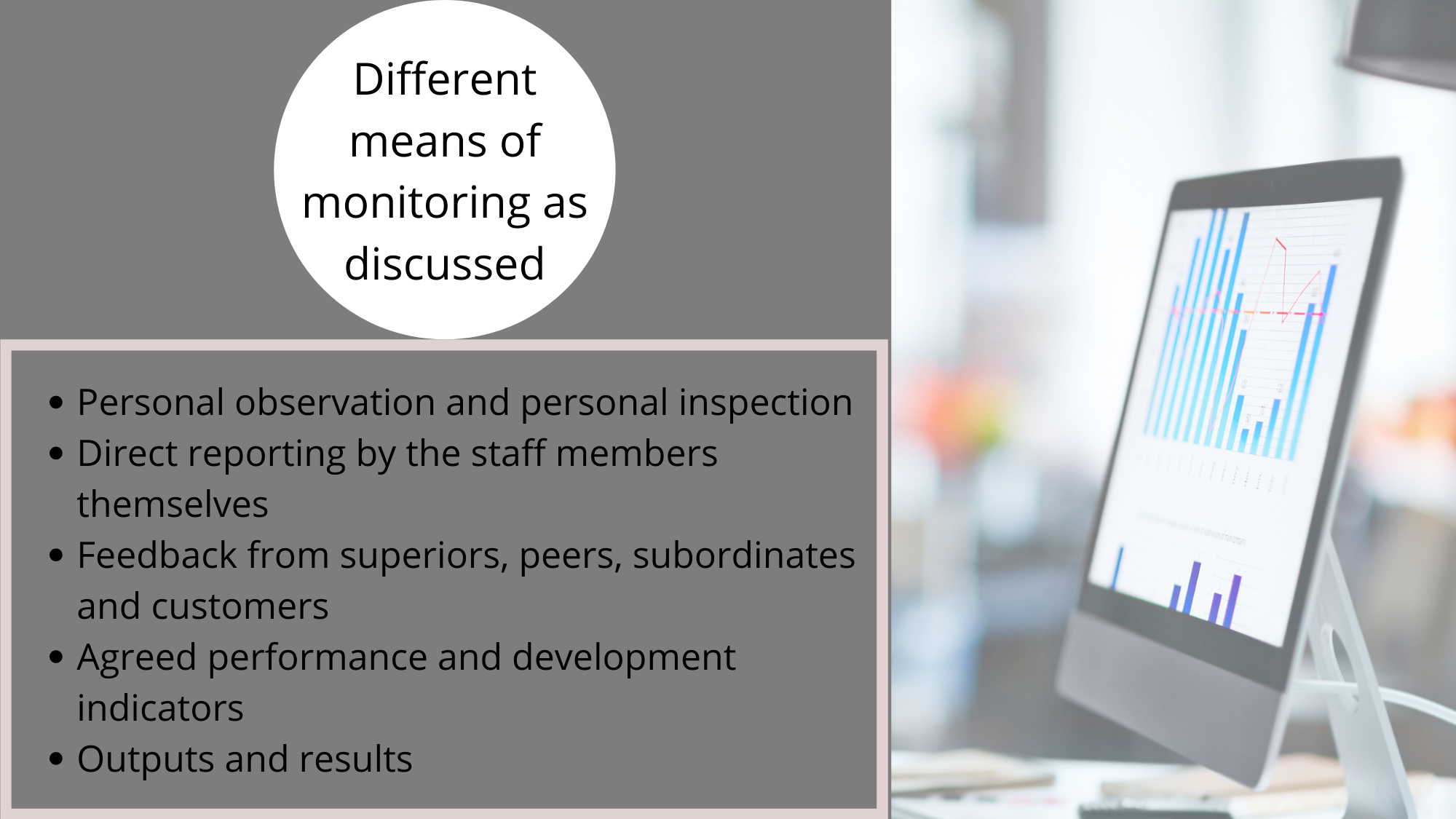
Consult And Agree On Performance Standards With Individuals And Teams
Click here to view a video that explains how to determining performance standards.
The purpose of this discussion is to agree on goals and objectives and tracking methods. This is especially important because it sets a positive tone while you gain the person’s commitment to performance levels and participation in the process. People are most committed to achieving individual and departmental objectives when they play an active role in setting them and carrying them out. To prepare them for involvement and to ensure their commitment, it is essential that they:
- Understand their role in the process.
- See how their KRAs and objectives are based on departmental and organisational goals and objectives.
- Receive coaching from their manager/supervisor when they develop their KRAs and objectives.
- Understand that they are responsible for tracking their own performance and choosing informative and reliable tracking methods.
The success of the reaching agreement discussion depends on how well the manager and staff member prepare. Preparation gives both parties an opportunity to focus on the levels of performance in goals and objectives that is important. It sets the stage for mutual involvement throughout the ensuing performance cycle.

Preparation for such a meeting should include the following aspects:
- Ask the staff member to identify tentative goals and objectives and tracking methods before coming to the discussion. By now you should have discussed the individuals’ role in the process and have coached the person so that he/she understands the role well enough to identify tentative goals and objectives.
- As the manager/supervisor, you should develop tentative goals and objectives for the person’s job as well.
- Decide ahead of time how to respond if the person resists challenging, yet achievable, objectives, and regular tracking of performance.
- Select a meeting place that is private and free from interruption. By avoiding interruption you are showing that you take the individual and the performance discussion seriously.
- Schedule enough time for open and frank discussion. You don’t want to rush this discussion. You want to have enough time to listen to the person’s concerns and identify goals and objectives that are acceptable to both parties.
Agreed Goals and Objectives

Ensure that agreed goals and objectives are clear and concise, that they specify the activities to be performed and the standard to which they are to be performed.

Discussing and reaching agreement on both performance and development objectives should be done according to the following procedure.
Open the Discussion
State the purpose and importance of this discussion and keep the following in mind:
- Welcome the staff member to this very important discussion and make them feel at ease. You could offer them something to drink or ask about their personal lives.
- Indicate that the purpose of this discussion is to agree on clear and concise Key Result Areas as well as goals and objectives that will support departmental and organisational objectives for the coming performance cycle.
- You will also have to decide and agree on performance indicators and time frames or monitoring frequency for each objective.
- Indicate that you will spend equal time on developing performance objectives and development objectives and that a similar process will be followed for both.
- Emphasise that the staff member’s involvement is critical throughout the discussion and that it will enhance their self-esteem.
- Let the staff member know what is in it for them. How is performance linked to reward, bonus, promotion opportunity, development of skills, etc.
Clarify the Processes and Procedures to be followed During the Discussion Regarding Agreement on Performance and Development Objectives
Review the format of the process and keep the following aspects in mind:
- The manager/supervisor should briefly explain the process, which include agreeing on KRAs and related goals and objectives as well as reaching agreement on performance indicators and time frame/monitoring frequency.
- Indicate that performance and development will be handled separately although they are of equal importance. You will handle development directly after performance.
- Continue to emphasise the importance of active participation as this maintains self-esteem and helps to build trust and commitment.

Discuss and Agree on the Performance and Development Objectives
Identify levels of performance for each performance and development objective. Be mindful of the following aspects:
- Start by clearly stating the KRA and the relevant objective. This is a good opportunity to share your opinion on the importance of the objective and its impact on the success of the department/organisation.
- Both parties should enter the discussion with tentative levels of performance objectives in mind. It is important to listen carefully to each other.
- Set two to four achievable but stretching objectives for each KRA.
- Reduce concerns the staff member might have, about setting targets too high, by referring to past performance that was at or near that level of performance.
- By providing information about the person’s skills you can show your confidence in their ability to achieve the desired level of performance.
- If the person seems unsure, listen and respond with empathy to show that you understand and care. This response will help reduce resistance.
- Share relevant background information and rationale to clarify why the objective is important.
- Continue to check for understanding so that there are no questions about the level of performance agreed to for each objective.
Determine Resource Requirements and Stay Aware of the Following
- The staff member might not have all the necessary skills, knowledge and experience to achieve the set objectives.
- Ask the staff member what support they would need. Being close to the job the staff member probably knows best what resources or assistance they would need to reach an objective.
- Indicate to the staff member how you could assist them in removing barriers or providing counselling, coaching, training, etc.

Confirm Monitoring Method, Time Frames and Frequency of Monitoring.
Be Mindful of the Following
- Because the staff member is responsible for achieving objectives she should identify monitoring methods, time frames and frequency of monitoring for each objective and assume most of the responsibility for monitoring.
- The methods chosen should be convenient, appropriate and based on existing monitoring methods where possible. If monitoring takes to much time and there are too much administration involved, it will be ineffective.
- Set follow-up dates for monitoring on actions the two of you agreed to take.
Summarise the Discussion
- A great deal has been covered during this discussion, it is therefore important to summarise the actions you have agreed to take.
- You might ask the individual to recap while you check your notes to be sure that you both agree.
Express Confidence
- This will boost the individual’s confidence in his abilities to achieve the set objectives throughout the ensuing performance cycle.
- This will also help to build self-esteem and end the discussion on a positive note.
Contract and Establish a Performance Monitoring Process with the Individual and/or Team.
Monitoring can be defined as setting up ongoing procedures to collect and review information and performance with a view to manage an organisation or ongoing activities within it.
Click here to view a video that explains difference between monitoring and evaluation.
To successfully monitor performance and development progress you need to establish performance indicators and time frames/monitoring frequency. The concept of continuous monitoring and measuring of individual, team and organisation performance is key to a successful Performance Management System. For performance to improve it is necessary that it be monitored and measured. Monitoring ensures, amongst other things, that products and services are delivered according to company standards, in acceptable quantities, at acceptable levels of quality, at agreed times and within budget and per customer requirement. Things that should be monitored are both production aspects like workflow, methods, procedures, cost and results and people aspects like perceptions, attitudes, relationships, co-operation and teamwork. There are different means of monitoring as discussed earlier.
They are:

Making it more practical, performance monitoring systems can include:
Verbal feedback, Inspection, Efficiency demonstration, Critical incident, Progress report, Statistics, Lists, Printouts, Sales figures, Financials, Comebacks, Complements/Complaints, Surveys, Customer feedback, Certificate of attendance, Certificate of competence, Test results, Diploma/Degree
Key actions that need to be performed are:
- Identify monitoring needs. Determine which processes or areas need to be monitored; identify what information needs to be obtained.
- Develop monitoring systems. Establish systems to monitor activities or outputs that are easy to use and that provide timely and pertinent information.
- Implement monitoring systems. Effectively put in place monitoring systems with minimal interruption for other organisational processes.
- Review data. Collect and review data on a regular basis to determine progress, anticipate needs and make necessary adjustments to personnel or processes.
Performance Indicators
There are various documents that can serve as sources of information when performance must be evaluated. Click here to download an example of performance indicators.
Time Frames / Monitoring Frequency
Click here to download an example of a time frames and monitoring frequency.